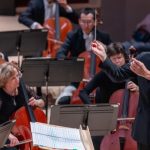May 30, 31 & June 1(m), 2025
Jones Hall
Houston, Texas – USA
Houston Symphony, Juraj Valčuha, conductor; Marina Prudenskaya, mezzo-soprano; Sopranos and Altos of the Houston Symphony Chorus, Julia hall, interim director; Houston Children’s Chorus, Stephen Roddy, founder and director
Gustav MAHLER: Symphony No. 3 in D minor (1896)
Lawrence Wheeler | 3 JUN 2025
Friday evening at Jones Hall, Houston Symphony music director Juraj Valčuha led the first of three performances of Mahler’s Symphony No. 3. Joined by mezzo-soprano Marina Prudenskaya and mixed choruses, this spectacular performance is an impressive finale to an outstanding season. It shows the conductor and orchestra in top form.
Mahler’s masterful orchestration utilizes a huge orchestra. His combinations of instruments create a varied palette of tone colors and a wide range of dynamics and expression. These were artfully curated by Valčuha and superbly realized by the Houston Symphony musicians. At more than 100 minutes, Mahler’s Third Symphony is the longest symphony in the standard repertoire, and it is challenging to regulate endurance and maintain concentration through its many moods. Valčuha deftly maneuvered the thunderous, spritely, martial, brooding, reverential, penitent, and life-affirming within, giving coherence to this massive work..
The monumental first movement alone is over 30 minutes long. Originally titled “Pan Awakes, Summer Marches In,” it has fits and starts, fragmented lines, unexpected climaxes, and is as unpredictable as the wind. It features the main theme thrice, emphasizing the cyclicality of nature. Throughout it all is a reverential, even celebratory quality, revealing an inner attitude not just of awe but of joy, an attitude reflected by Valčuha’s animated conducting. The ending of the first movement is a rapturous fanfare vivified by Valčuha with a precise baton and gleaming grin.
Mahler wrote there should be “a long pause” after the first movement. This was accomplished by having the choirs file onto the risers. All the singers, including the children, made a disciplined entrance.
The second movement is a landler-esque Minuet, the more sumptuous sections of which were coaxed out of the orchestra by an expressive Valcuha. This is music with which he clearly and joyfully identifies.
In the fourth and fifth movements, mezzo-soprano Marina Prudenskaya sang with an expressive and vowel-based tone, sounding closer to an alto or even a contralto. Her commanding stage presence personified the two songs.
I admired how still the children sat until their part in the fifth movement. They sang wonderfully, seamlessly joining the adult sopranos and altos. The women’s chorus was expressive and animated, with the well-trained children’s choir adding joyful bell sounds.
The final movement, titled “What Love Tells Me,” contains the dignity of Beethoven but with a running undercurrent of chromaticism. Conducting sans baton, Valčuha modulated the unfolding of the strings’ melody with the spirituality of Wagner’s Lohengrin. The grand and life-affirming conclusion was sublimely spectacular as well as tears-inducing.
There were manifold exemplary solos throughout the orchestra, in fact, too many to list. Mention should be made of the three solo brass players in Mahler’s brass-heavy score. Principal horn William VerMeulen led the excellent horn section while contributing several fine solos. Principal trumpet Mark Hughes played the third movement off-stage solo with an extemporaneous and congenial quality. Principal trombone Nick Platoff’s heart-felt first movement solo was tonally rich and with the clarity of a valve instrument. It would be difficult to imagine a finer rendition.
Houston is fortunate to have performances of this caliber. They should not be missed. ■
EXTERNAL LINKS:
- Houston Symphony: houstonsymphony.org
- Juraj Valčuha: jurajvalcuha.com
- Marina Prudenskaya: prudenskaya.de
- Houston Symphony Chorus: houstonsymphony.org/about-us/chorus
- Houston Children’s Chorus: houstonchildren.org

Read more by Lawrence Wheeler.
RECENT POSTS
 The Atlanta Opera conjures a night of enchantment as Glass’ score reawakens Cocteau’s ‘La Belle et la Bête’ • 20 Nov 2025
The Atlanta Opera conjures a night of enchantment as Glass’ score reawakens Cocteau’s ‘La Belle et la Bête’ • 20 Nov 2025 Jan Lisiecki on discipline, performance psychology, and programming for his Spivey Hall recital • 17 Nov 2025
Jan Lisiecki on discipline, performance psychology, and programming for his Spivey Hall recital • 17 Nov 2025




.png)